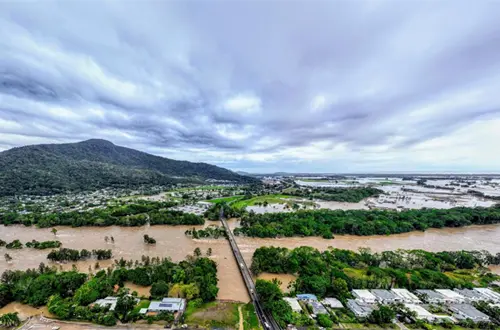Emergency Plan for Cargo Transportation in Response to Queensland Floods
Unprecedented rains from Tropical Cyclone Jasper have caused widespread flooding across far north Queensland, closing Cairns Airport, severely damaging roads and leaving residents on the city's northern beaches isolated.
More than 500mm of rain has fallen in the Barron River Basin since 9am on Sunday, according to the Bureau of Meteorology.
Cairns, now an island in Far North Queensland, has seen roads blocked in its north, south and west due to the worst flooding in more than 100 years. The full impact of the flooding is not yet known. But there could be significant damage to property and public infrastructure, with negative impacts on industries such as tourism and agriculture. Recovery can take months.

Australia has been plagued by disasters in recent years, including severe droughts and bushfires, years of record floods and six mass bleaching events on the Great Barrier Reef, fueling concerns about the effects of climate change.
The major floods in northern Australia have begun to ease and the intensity of rainfall has weakened.
When faced with a natural disaster like the Queensland, Australia, floods, a comprehensive and flexible cargo transportation contingency plan is crucial. Through careful planning and clear execution, ChinaDivision can minimize the impact of flooding on cargo. Here is a comprehensive guide to help you develop a cargo transportation contingency plan for such situations:
risk assessment
Identify vulnerable routes: Conduct detailed analysis of transport routes that may be affected by flooding. Work closely with local authorities and weather services to take flood-prone areas into account.
Cargo Susceptibility Analysis: Cargo is classified based on its susceptibility to water damage. For critical or time-sensitive shipments, priority should be given to shipping.
communication and coordination
Establish a communication protocol: Develop a clear communication plan for drivers, dispatchers and other relevant personnel, and set up multiple channels to update information in real time.
Work with authorities: Establish strong links with local emergency services, government agencies and weather forecast services for timely access to flood warnings and road closures.
Precaution
Conduct flood awareness training on safety procedures and evacuation routes. Make sure drivers understand the importance of monitoring weather forecasts.
Vehicle maintenance: Check and maintain your vehicle regularly to ensure it is in a flood-ready state. Equip your vehicle with necessary safety tools such as life jackets and emergency kits.
emergency response protocol
Evacuation Procedures: Develop a detailed evacuation plan for drivers in flood-prone areas, including designated safety zones and alternative routes.
Cargo protection: Provide waterproof packaging for sensitive cargo and equip vehicles with waterproof containers or lids.
Technology integration
Real-time tracking: Real-time monitoring of vehicles through a GPS tracking system, combined with telematics technology to re-plan vehicle routes based on real-time traffic and weather data.
Communication technology: Utilize communication tools such as two-way radios or mobile apps for instant information updates.
emergency supplies
Driver Emergency Kit: Equip drivers with emergency supplies such as water, non-perishable food, and first aid kits.
Vehicle emergency supplies: Includes emergency repair tools and flood area recovery equipment.
emergency procedures
Assessment and reporting: Conduct detailed assessments following a flood to understand the impact on cargo and infrastructure, and report findings to relevant stakeholders and authorities.
Continuous improvement: Analyze the effectiveness of contingency plans and update them based on actual experience. Regular drills and training sessions are conducted to continuously improve the program.
As a professional transportation service provider, ChinaDivision has rich experience and professional skills and is able to provide customers with efficient and reliable cargo transportation services. In terms of flood emergency response, ChinaDivision has a professional transportation team and advanced logistics technology, which can respond quickly and take effective measures to ensure the safe delivery of goods.
In the face of emergencies such as natural disasters, ChinaDivision can quickly initiate emergency response procedures, work closely with relevant parties, and provide timely rescue and support. We have a professional transportation team and rich experience, able to respond quickly and take effective measures to ensure the safe delivery of goods. If you need professional cargo transportation services, ChinaDivision will be your best choice. We are committed to providing you with efficient and reliable logistics services to ensure that your goods arrive at their destination safely and on time.





